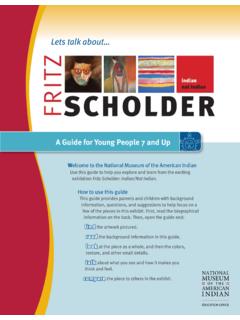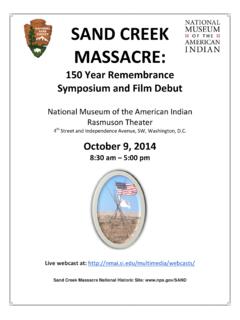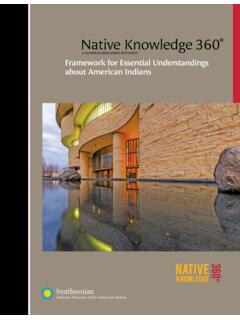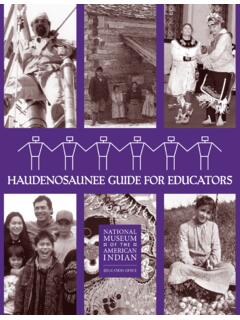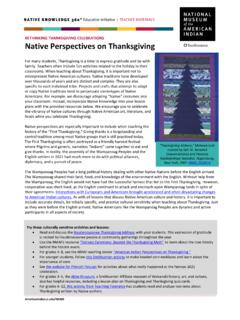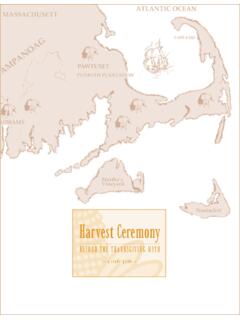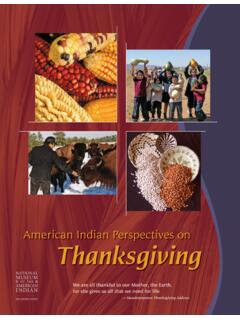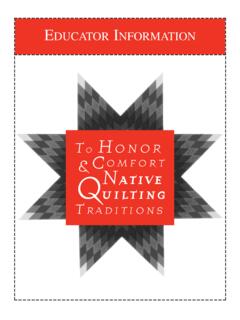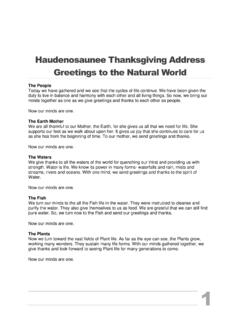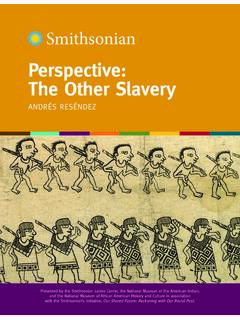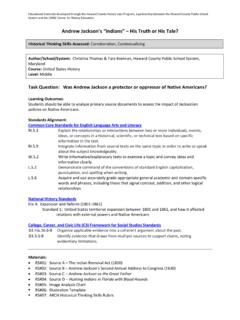Transcription of Did You Know? Facts About American Indian Removal
1 American Indian Removal What Does It Mean to Remove a People? Did You Know? Facts About American Indian Removal 1. In 1813, andrew jackson and his wife, Rachel, adopted an orphaned Muscogee (Creek) boy named Lyncoya, who died at age 16 of tuberculosis, months before jackson was elected president (1828) and two years before Congress passed the Indian Removal Act (1830).1 2. Lawmakers were deeply divided over the Indian Removal Act.
2 The Senate vote was 28 to 19 in favor. The vote in the House of Representatives was even closer, 102 to 97. President andrew jackson signed the measure into law on May 28, 3. The legendary frontiersman and Tennessee congressman Davy Crockett opposed the Indian Removal Act, declaring that his decision would not make me ashamed in the Day of Judgment. 3 4. In 1829, the Christian missionary Jeremiah Evarts published a series of newspaper articles that blasted Indian Removal , then being debated in Congress. Using the pseudonym William Penn, the name of the seventeenth-century Quaker founder of Pennsylvania and apostle of peace with indians , Evarts reminded readers of America s moral obligation to honor treaties with Native nations.
3 His William Penn Essays became one of the most widely discussed political pamphlets since Common Sense (1776), Thomas Paine s influential argument for American independence from Great 5. In Worcester v. Georgia (1832), the Supreme Court ruled that the Cherokee Nation was sovereign and that the State of Georgia had no right to extend its laws over the nation. Ignoring the ruling, President andrew jackson supported Georgia s attempts to remove the 5 Cherokee from their Between 1830 and 1850, the government used treaties, gun- and bayonet-toting soldiers, and private contractors to remove About 100,000 Native Americans from their eastern homelands to territories west of the Mississippi River.
4 During andrew jackson s presidency alone (1829 1837), some 46,000 Native people were removed to the West, opening more than 100 million acres of tribal land for white 7. Approximately 8,000 Cherokees died during Removal to Indian Territory in 1838 1839. One of the victims was Quatie, wife of Cherokee chief John Ross, who contracted pneumonia after giving her blanket to a sick 1 American Indian Removal What Does It Mean to Remove a People?
5 8. During the Muscogee (Creek) Removal of 1836, Chief Eneah Micco and his people were chained and force-marched from east Alabama to Montgomery. One observer remarked that it moved the stoutest heart .. to see .. a once mighty people fettered and chained together, forced to depart from the land of their fathers into a country unknown to them. 8 9. As thousands of Cherokees marched west along the Trail of Tears in 1838, 800 Potawatomis, most belonging to Chief Menominee s band, were forcibly removed from their homelands in northwestern Indiana to eastern Kansas. Approximately 43 people, including at least 28 children, died along the 660-mile route, which became known as the Trail of The name Trail of Tears first appeared in print in 1908, when it was used to describe Indian Removal in a history of 11.
6 One-quarter of the Choctaw Nation took advantage of an 1830 treaty provision that allowed them to remain in Mississippi if they registered for private land allotments and obeyed state laws. Many Choctaws later lost their Mississippi lands to shady speculators who purchased the property for a fraction of its 12. Indian Removal was expensive. The government paid $20 million ( About $4, per person) to relocate some 4,400 Seminoles from Florida to Indian Territory from the 1830s After Removal , former Choctaw and Chickasaw lands in Mississippi became a magnet for men looking to get rich quickly by buying land cheaply and reselling it at a profit. In 1836, one such man on the make declared that Mississippi was in truth the only country I ever read or heard of, where a poor man could in 2 or 3 years.
7 Become wealthy. 13 14. In 1807, Shawnee chief Catahecassa (Black Hoof) and his band welcomed the arrival of a Quaker missionary who encouraged them to adopt Anglo- American farming methods at Wapakoneta, their village in Ohio. The Shawnees began to use plows to till sprawling fields planted with crops that were enclosed by wooden fences. Some Shawnees built log homes, raised livestock, tended orchards, and used local sawmills and gristmills. But following the white man s road failed to protect the Shawnees from land-hungry Americans. In 1831, they signed a Removal treaty in which they agreed to immigrate to 15. For many tribal nations, Indian Removal involved constant uprooting and relocation.
8 The Ho-Chunk were removed from Wisconsin to northeastern Iowa (1840 1846), from Iowa to Long Prairie, Minnesota (1846 1855), from Long Prairie to Blue Earth, Minnesota (1855 1863), from Blue Earth to Crow Creek, South Dakota (1863 1865), and finally to Nebraska in 1865. Some 700 Ho-Chunk died in the shuffle. By 1880, half of the nation had returned to 2 American Indian Removal What Does It Mean to Remove a People?
9 16. Native memories of Removal were passed on from generation to generation through stories, songs, and personal names. In the early 1900s, visitors to Oklahoma could still meet Seminoles named A -ba-yik -ha-tco, or people going, It-tcai-hi, or the one who shoots, Ingalee, or scared, and Ahichakitag, or looking back. 16 17. In 1890, on his eightieth birthday, John G. Burnett described to his children the horrors he had witnessed years before when he served as a Army private engaged in the Removal of the Cherokees. In his letter, Burnett lamented that modern schoolchildren knew nothing About the crime of Indian Removal or its legacy: that we are living on lands that were taken from a helpless race at bayonet point to satisfy the white man s greed.
10 17 18. Different American Indian nations reacted to issues of Removal in different ways. For many years, American Indian leaders made difficult choices by planning strategically and relying on their community s cultural, political, and military strength to avoid Removal . While the process of Removal created upheaval, suffering, and death among Indian people, it was not the end for American indians . They have survived and thrive as their own cultural and political entities today. 1 Sean Wilentz, The Rise of American Democracy: Jefferson to Lincoln (New York: W. W. Norton, 2005), 325. 2 Francis Paul Prucha, The Great Father: The United States Government and the American indians (Lincoln: University of Nebraska Press, 1984), 206.
